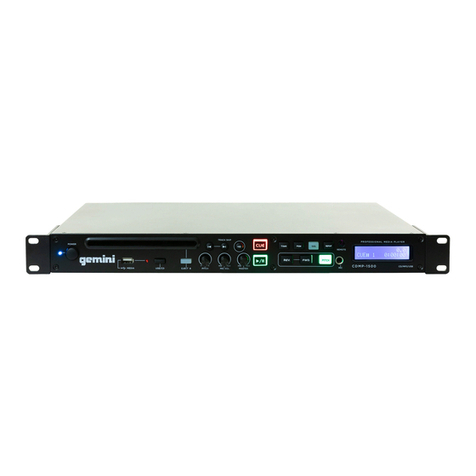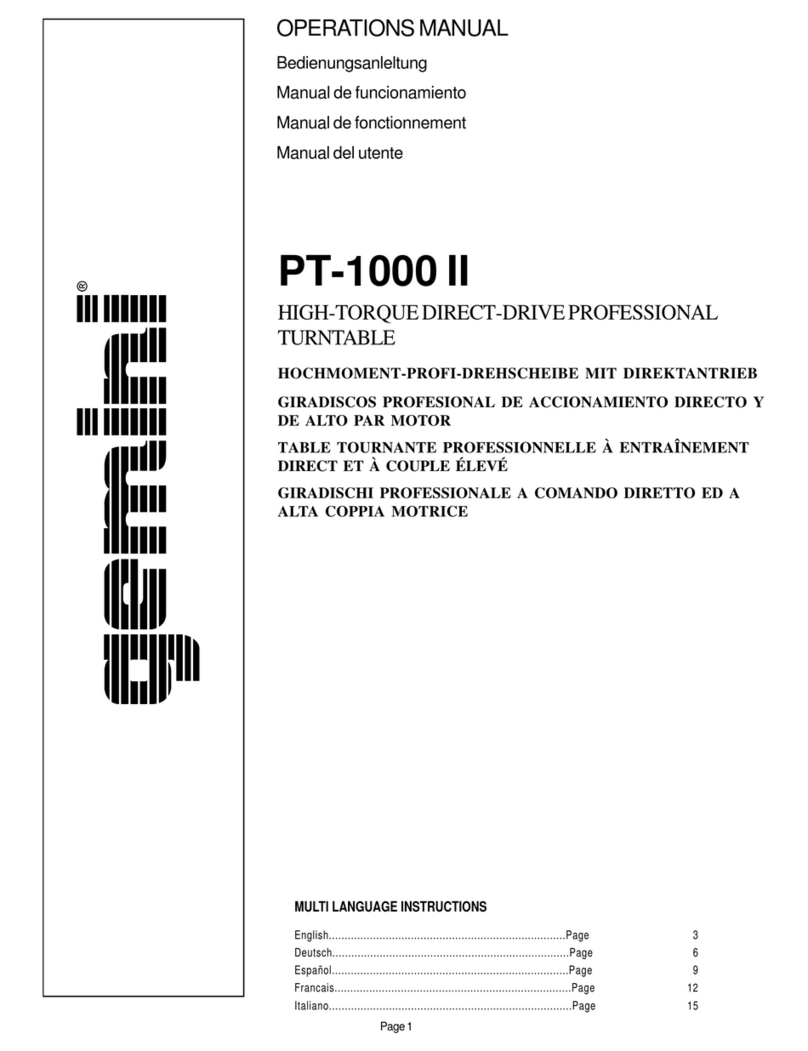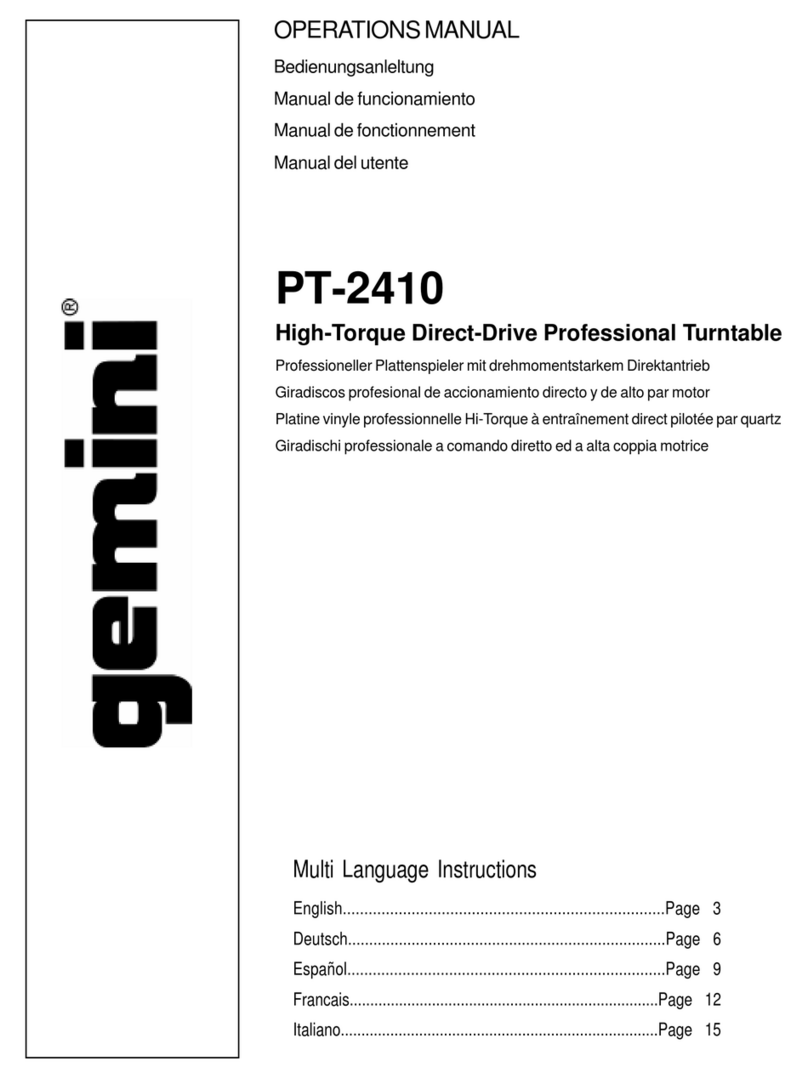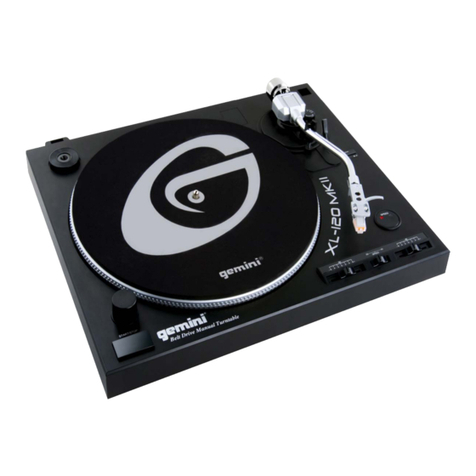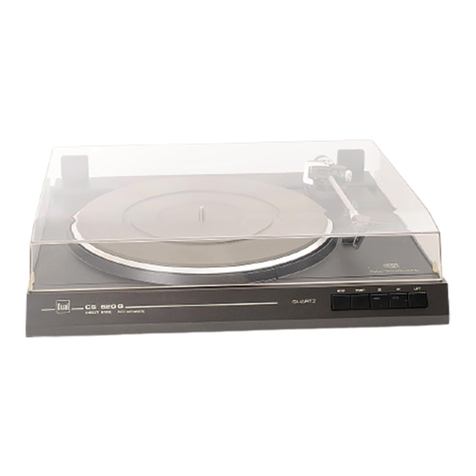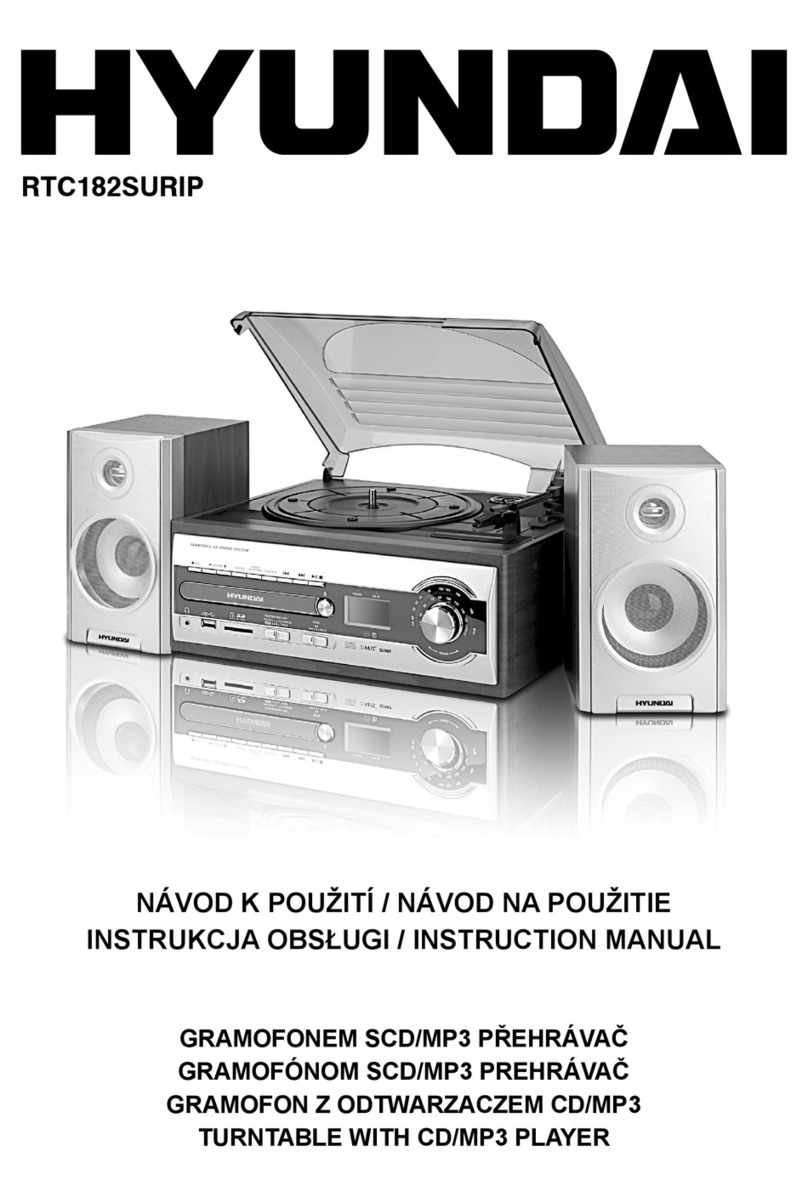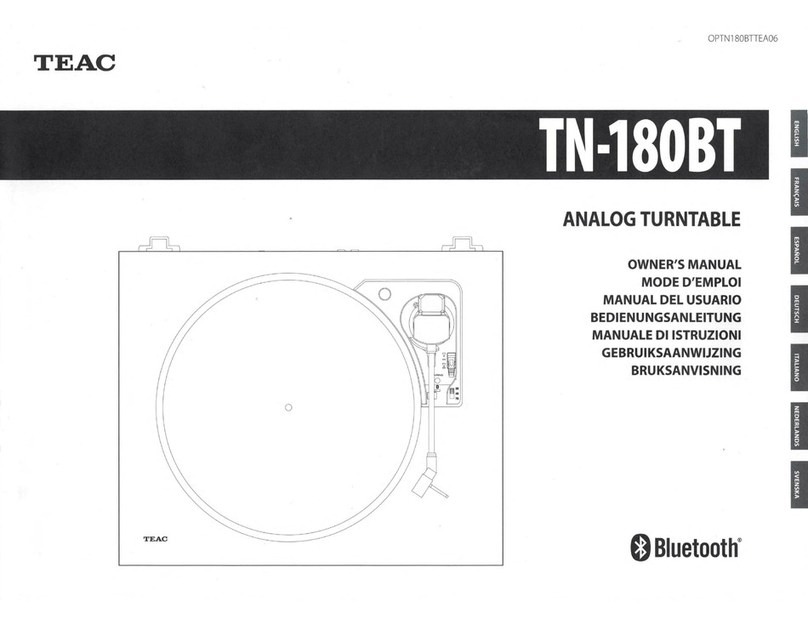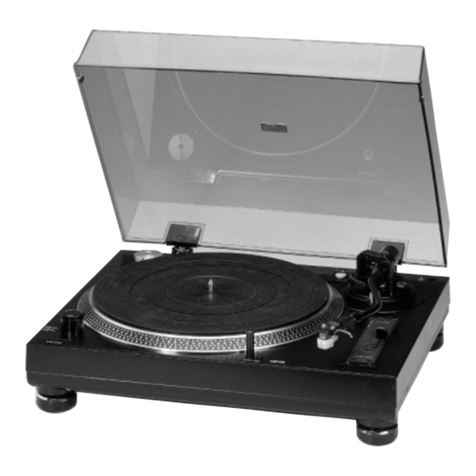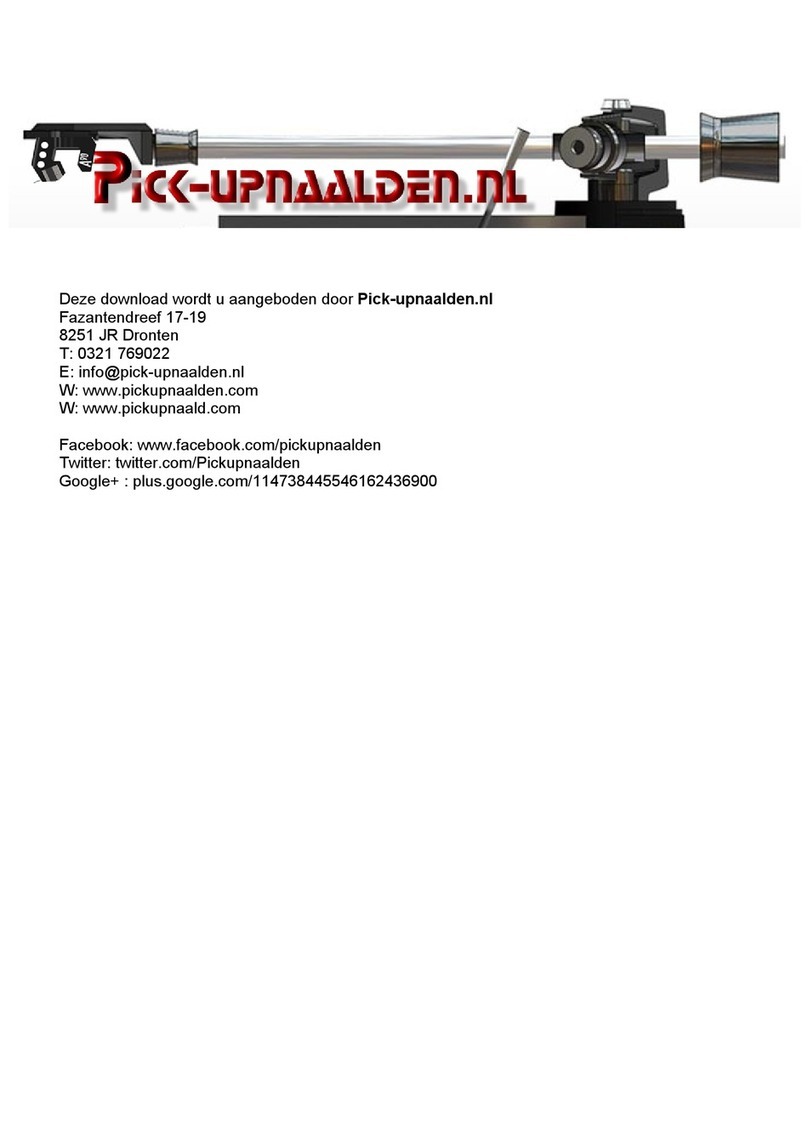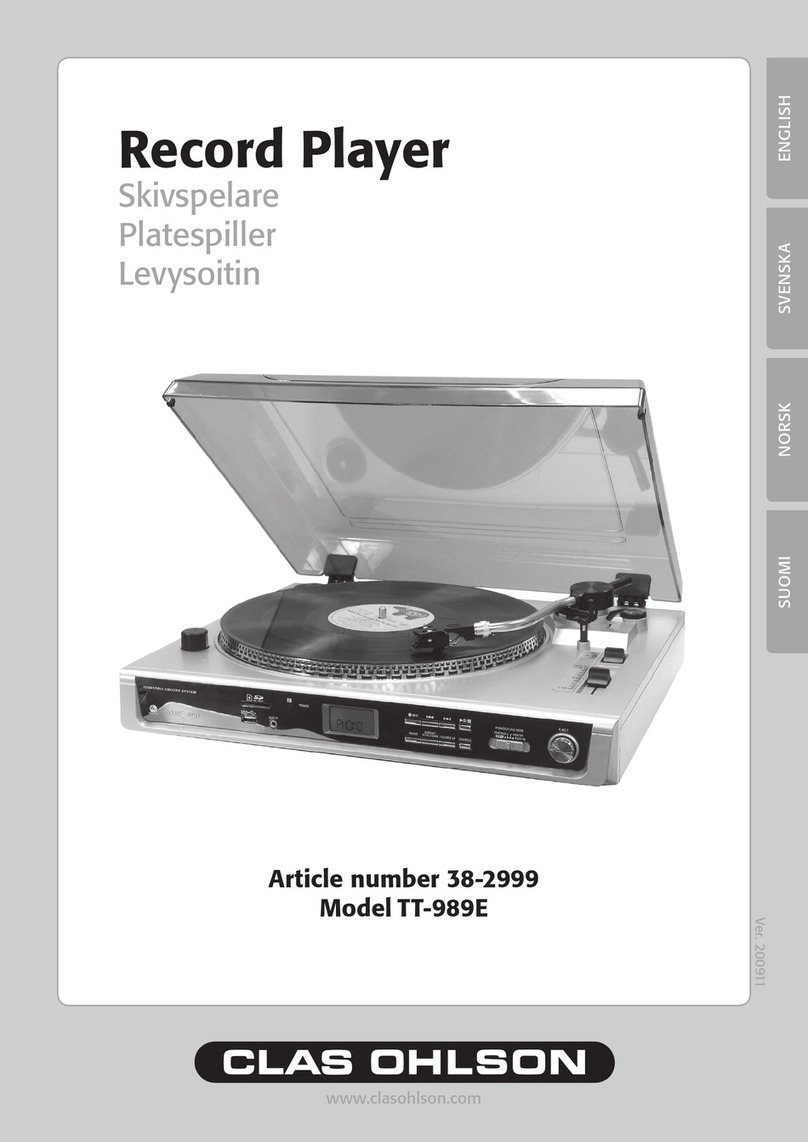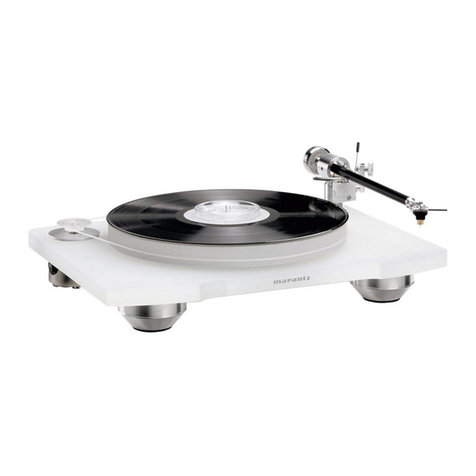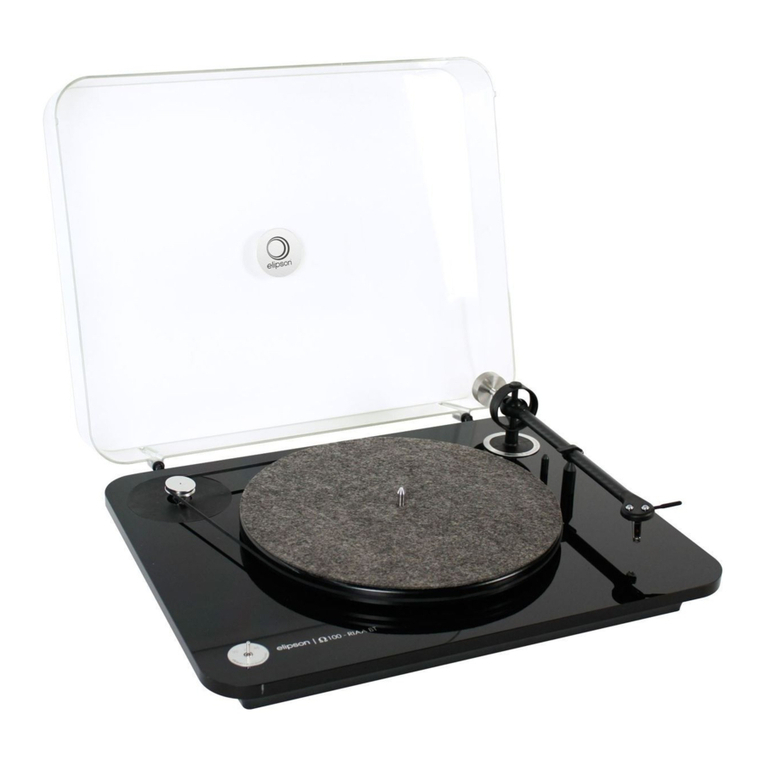Gemini XL-200 User manual

(1)
OPERATIONS MANUAL
BEDIENUNGSHANDBUCH
MANUAL DEL OPERADOR
MANUEL D’INSTRUCTIONS
XL-200
BELT-DRIVE MANUAL TURNTABLE
MANUELLER PLATTENSPIELER MIT RIEMENANTRIEB
GIRADISCOS MANUAL ACCIONADO POR CORREA
TABLE TOURNANTE MANUELLE ENTRAÎNÉE PAR COURROIE
MULTI LANGUAGE INSTRUCTIONS:
English...............................................................................................................Page 4
Deutsch.............................................................................................................Page 6
Español..............................................................................................................Page 8
Francais..........................................................................................................Page 10

(2)
Figure 1
XL-200
2
3
4b
4a
5
1
6
8
6
9
9
11
12
13
14
15 17
19
16
21
20
18

(3)
Figure 2
Figure 3

(4)
INTRODUCTION:
Congratulations on purchasing a Gemini XL-200 turntable. This state of
the art turntable includes the latest features. Prior to use, we suggest that
you carefully read all the instructions.
FEATURES
• ±10% Pitch control:
• Strobe illuminator
• Soft-touch start/stop switch
PRECAUTIONS:
1. Read all operating instructions before using this equipment.
2. The apparatus should not be exposed to dripping or splashing, and no
objects filled with liquids such as vases should be placed on the apparatus.
3. To reduce the risk of electrical shock, do not open the unit. There are
NO USER REPLACEABLE PARTS INSIDE. Please contact the Gemini
Service Department or your authorized dealer to speak to a qualified
service technician.
4. Tone Arm bearings are factory set and sealed. Any attempt at adjustment
will void the warranty.
5. Be sure that all AC power is OFF while making connections.
6. Cables should be low capacitance, shielded and of proper length. Make
sure that all plugs and jacks are tight and properly connected.
7. Always begin with the audio level faders/volume controls set at minimum
and the speaker volume control(s) set to OFF. Wait 8 to 10 seconds prior
to turning up the speaker volume to prevent the transient “POP” that
could result in speaker/crossover damage.
8. DO NOT EXPOSE THIS UNIT TO RAIN OR MOISTURE.
9. DO NOT USE ANY SPRAY CLEANER OR LUBRICANT ON ANY
CONTROLS OR SWITCHES.
PARTS CHECKLIST:
Turntable unit...............................................................................................1
Dust cover hinge..........................................................................................2
Turntable platter...........................................................................................1
45 RPM adapter...........................................................................................1
Slipmat.........................................................................................................1
Counter balance..........................................................................................1
Dust cover....................................................................................................1
Headshell.....................................................................................................1
ASSEMBLY AND SET-UP:
NOTE: SEE FIG. 1 FOR PART NUMBERS AND LOCATIONS.
VOLTAGE SELECTION:
Rotate the PLATTER (2) until the VOLTAGE SELECTOR (3) (located on
the TURNTABLE BASE (1)) is visible through one of the platter holes.
Make sure that the VOLTAGE SELECTOR switch is set to the correct
voltage. WARNING: If you try to operate the turntable with the incorrect
voltage setting, it can damage your turntable.
ATTACHING THE TURNTABLE BELT:
The TURNTABLE BELT (4A) comes attached to the PLATTER (2) and
the MOTOR SPINDLE (4B) but can some times detach in shipping.
Rotate the PLATTER (2) and look through the platter holes to check if belt
detached. If the belt is not wrapped tightly around the platter and the
MOTOR SPINDLE, you need to reattach it.
1. Remove the platter and wrap the belt around the inner circle under the
platter. DO NOT STRETCH OUT THE BELT.
2. Replace the platter and rotate the PLATTER (2) until the MOTOR SPINDLE
(4B) is visible, then fit your fingers in hole on the top of the PLATTER (2), feel for
and grab the rubber belt and attach to the motor spindle.
3. Replace the locking washer.
TURNTABLE INSTALLATION:
1. Put the SLIPMAT (5) on the PLATTER (2).
2. Set the TURNTABLE BASE (1) on a flat, level surface free of vibration.
Use the turntable feet to horizontally stabilize the unit.
3. Try to place the unit as far away from the speakers as possible.
4. Keep the unit away from direct exposure to the sun, heat, moisture or dirt.
5. Keep the unit well ventilated.
CARTRIDGE INSTALLATION: (SEE FIG. 2)
Because all cartridges have their own designs, please refer to your
particular cartridge’s instructions to insure proper installation.
1. Connect the lead wires to the cartridge terminals. For your convenience,
the terminals of most cartridges are color coded. Connect each lead wire
to the terminal of the same color.
White (L+).................Left Channel +
Blue (L-)...................Left Channel -
Red (R+)....................Right Channel +
Green (R-).................Right Channel -
2. Mount the cartridge in the HEADSHELL (6) and tighten it with the screws
included with the cartridge.
ATTENTION STANTON 680 CARTRIDGE USERS
When using a Stanton 680 or similar cartridge, where the body is
grounded to a cartridge terminal, remove the grounding strap from the
cartridge body to the cartridge ground terminal. Failure to do this may
result in excessive hum.
HEADSHELL INSTALLATION:
Insert the HEADSHELL (6) into the front of the tubular TONE ARM (7). While
holding the HEADSHELL firmly in a horizontal position, turn the LOCKING NUT
(8) counter clockwise until the HEADSHELL is locked in place.
COUNTERWEIGHT INSTALLATION: (SEE FIG. 3)
1. Slide the COUNTERWEIGHT (9) onto the rear of the TONE ARM (7)
with the numbered stylus gauge facing forward.
2. Twist the COUNTERWEIGHT (9) lightly counter clockwise, to screw it
onto the rear of the TONE ARM (7) .
ADJUSTING HORIZONTAL ZERO (0) BALANCE AND
STYLUS PRESSURE:
1. Without touching the stylus tip, remove the stylus protector (if your
cartridge has a detachable one).
2. Release the ARM CLAMP (10) and lift the TONE ARM (7) off the ARM
REST (11).
3. Counter clockwise advancement of the COUNTERWEIGHT (9) will
cause the cartridge side of the TONE ARM (7) to be lowered. Clockwise
will cause the opposite. Turn the COUNTERWEIGHT clockwise or
counter clockwise as needed until the TONE ARM is balanced
horizontally. You can easily tell this by watching for the point where the
TONE ARM “floats” freely.
4. Place TONE ARM (7) on ARM REST (11) and lock it in place with the
ARM CLAMP (10).
5. With the TONE ARM (7) locked on the ARM REST (11), hold the
COUNTERWEIGHT (9) steady with one hand while rotating the STYLUS
PRESSURE RING (12) until the numeral “0” on the ring aligns with the
center line on the TONE ARM rear shaft. The horizontal zero (0) balance
should be completed.
6. Refloat the TONE ARM to ensure horizontal zero (0) balance. If zero
balance has not been maintained, repeat counterweight steps 3 - 5.

(5)
7. After adjusting the horizontal zero (0) balance, turn the balanced
COUNTERWEIGHT (9) counter clockwise until the cartridge
manufacturer’s recommend stylus pressure appears on the STYLUS
PRESSURE RING (12) where it meets the center line of the TONE ARM
(7) rear shaft.
ADJUSTING THE ANTI-SKATING CONTROL:
Set the ANTI-SKATING CONTROL (13) to the same value as the stylus
pressure.
NOTE: IF YOUR TURNTABLE CAME WITH A CN-25 CARTRIDGE, IT HAS
A RECOMMENED TRACKING FORCE OF 3.0 GRAMS AND CAN HAVE
RANGE FROM 2.5-3.5 GRAMS.
INSTALLING THE DUSTCOVER:
1. Hold the dustcover in position, directly above the turntable, and slide the
hinge bases into the holders mounted on the rear panel.
2. Always raise the dustcover before removal.
3. Avoid opening and closing the dustcover during play. Undesirable
vibration and stylus skipping can result.
CONNECTIONS:
1. Plug the AC power plug into an appropriate outlet.
2. See Table A for proper connection of the output RCA plugs and ground
connector. Make sure that all the plugs are firmly plugged into the
appropriate jacks (phono inputs). To reduce hum, make sure the ground
lug is firmly connected to the ground screw.
TABLE A
OPERATING INSTRUCTIONS:
BASIC OPERATION:
1. Place a record on the SLIPMAT (5) which sits on the PLATTER (2).
2. Select the desired speed by depressing the 33 or 45 SPEED
SELECTOR (14) button.
3. Turn the POWER (15) switch to the “ON” position, at which point the
STROBE LIGHTS (16) and the speed indicator (for the selected speed)
will illuminate.
4. Remove the stylus protector (if applicable to your cartridge).
5. Release the ARM CLAMP (10) found on the ARM REST (11).
6. Push the START/STOP (17) button. The turntable PLATTER (2) will start
to spin.
7. Push the CUE LEVER (18) to the “UP” position.
8. Position the tone arm over the desired position on the record and push
the CUE LEVER to the “DOWN” position. The TONE ARM (7) will
slowly lower onto the record at which time play will begin.
9. When play is over, raise the TONE ARM, move it to the ARM REST, and
secure it with the ARM CLAMP.
10.You now have the option of turning off the power by turning the POWER
(15) switch to the “OFF” position, or stopping the PLATTER (2) by
pushing the START/STOP (17) button.
INTERRUPTING PLAY:
1. Pushing the CUE LEVER (18) to the “UP” position will cause the TONE
ARM (7) to lift stopping play.
2. Pushing the CUE LEVER (18) to the “DOWN” position will cause the
TONE ARM (7) to slowly lower onto the record at the point where play
was interrupted.
L (WHITE)
R (RED)
GND (Spade Lug)
MIXER OR RECEIVER
OUTPUT CONNECTORS
PHONO L CHANNEL
PHONO R CHANNEL
GND Screw
PLAYING 45 RPM RECORDS:
1. When playing a 45 RPM record with a large center hole, first place the
45 ADAPTER (19) on the center spindle.
2. Be sure that the 45 SPEED SELECTOR (14) button is pushed and the
45 speed indicator is illuminated.
ADJUSTING THE PITCH CONTROL:
1. The XL-200 is equipped with a PITCH CONTROL (20). When the PITCH
CONTROL is in the center position the speed will be 33 or 45 depending
on which SPEED SELECTOR (14) button is pushed.
2. When the PITCH CONTROL (20) is positioned off center, the pitch can
vary ±10% depending on the position of the PITCH CONTROL.
3. The PLATTER (2) is equipped with a STROBE RPM INDICATOR STRIP
(21). When the PLATTER (2) is spinning, the STROBE LIGHTS (16)
illuminate the STROBE RPM INDICATOR STRIP. At 60 Hz the bottom
row of dots will appear to be stationary when the speed of the platter is
exactly 45 RPM and the second row from the bottom will appear to be
stationary at 33 RPM. At 50 Hz, the second row from the top represents
45 RPM and the top row represents 33 RPM.
SPECIFICATIONS:
TURNTABLE SECTION:
Type.......................................................................Belt Drive Manual Turntable
Drive Method.......................................................................................Belt Drive
Motor...................................................................................................DC Motor
Speed.....................................................................................33 1/3 or 45 RPM
Wow and Flutter.........................................................Less than 0.25% WRMS*
* This rating refers to the turntable assembly and platter only and excludes
effects of records, cartridges or tonearms.
TONEARM SECTION:
Type.....................................................Statically Balanced S-Shaped Tonearm
Headshell Weight.......................................................................................5.6 g
GENERAL:
Power Supply.................................................................115V 60Hz/230V 50Hz
Power Consumption...............................................................................5 Watts
Dimensions.....................................17.75" x 5.75" x 14" (450 x 146 x 352 mm)
Weight.........................................................................................8 lbs. (3.75 kg)
SPECIFICATIONS ARE SUBJECT TO CHANGE WITHOUT NOTICE.
THE WEIGHT AND DIMENSIONS SHOWN ARE APPROXIMATE.

(6)
EINLEITUNG:
Wir gratulieren Ihnen zum Kauf eines Gemini XL-200 Plattenspielers.
Dieses hochentwickelte erstklassige Gerät enthält die neuesten
Leistungsmerkmale. Vor Anwendung dieses Plattenspielers bitte alle
Anweisungen sorgfältig durchlesen.
LEISTUNGSMERKMALE
• ± 10% Tonhöhenabstimmung
• Strobelicht
• Start-/Stop-Funktionstaste
VORSICHTSMANAHMEN
1. Vor Anwendung dieses Geräts bitten alle Anweisungen sorgfältig
durchlesen.
2. Das Gerät vor Tropfen und Spritzern schützen, und es dürfen keine mit
Flüssigkeit gefüllte Behälter wie Vasen darauf gestellt werden.
3. Das Gerät nicht öffnen, um das Risiko elektrischen Schocks zu mindern.
Es enthält KEINE VOM ANWENDER ERSETZBAREN TEILE. Die
Wartung darf nur von befähigten Wartungstechnikern durchgeführt
werden.
4. Die Tonarmlager sind werkseingestellt und abgedichtet. Jegliche
Änderungsversuche machen die Garantie ungültig.
5. Darauf achten, da beim Anschlu die Wechseltromleistung abgeschaltet ist.
6. Nur kapazitätsarme, abgeschirmte Kabel vorschriftsmäiger Länge
benutzen. Darauf achten, da alle Stecker und Buchsen fest
angeschraubt und richtig angeschlossen sind.
7. Zu Beginn müssen die Tonpegelüberblender und Lautstärkenregler auf
Mindeststärke eingestellt und der (die) Lautstärkenregler in OFF-Position
geschaltet sein. Vor dem Lauterstellen 8 bis 10 Sekunden warten, um
den durch Einschwingung erzeugten Schroteffekt zu vermeiden, welches
zu Lautsprecher- und Frequenzweichenschaden führen könnte.
8. Dieses Gerät nicht Regen oder Feuchtigkeit aussetzen.
9. An den Reglern oder Schaltern kein Spray-Reinigungsmittel oder
Schmiermittel benutzen.
TEILE-CHECKLIST:
Plattenspieler...............................................................................................1
Plattenteller..................................................................................................1
Plattentellerauflage......................................................................................1
Abdeckhaube...............................................................................................1
Abdeckhaubenscharnier..............................................................................2
45-U/min-Adapter........................................................................................1
Balancegewicht...........................................................................................1
Tonkopf........................................................................................................1
ZUSAMMENBAU UND ANORDNUNG:
HINWEIS: SIEHE ABBILDUNG 1 FüR TEILENUMMERN UND
POSITIONEN.
SPANNUNGSAUSWAHL:
Den PLATTENTELLER - PLATTER (2) rotieren bis den
SPANNUNGSWAHLER - VOLTAGE SELECTOR (3) (befindet sich auf
dem PLATTENSPIELERCHASSIS - TURNTABLE BASE (1)) sichtbar ist
durch ein Loch des Plattentellers. Den VOLTAGE SELECTOR (3) auf der
richtigen Spannung setzen. WARNUNG: Lassen Sie den PLATTER
rotieren mit einer falschen Spannungseinstellung, dann kann der
Plattenspieler sich beschädigen.
WIE MAN DEN PLATTENTELLERRIEMEN ANBRINGT:
Der RIEMEN - TURNTABLE BELT (4A) wird am unteren Ende des PLATTER
(2) und der MOTORWELLE - MOTOR SPINDLE (4B) befestigt geliefert, kann
sich manchmal aber beim Versand lösen. Den PLATTER drehen und durch die
Löcher im Plattentellerchassis blicken, um nachzuprüfen, ob der Riemen
angebracht ist. Wenn der Riemen nicht fest um das Plattentellerchassis und die
MOTORWELLE angelegt ist, muß er neu angelegt werden.
1. Das Plattentellerchassis abnehmen, und den Riemen um den inneren
Ring unter das Plattentellerchassis legen. DEN RIEMEN NICHT
DEHNEN.
2. Den PLATTENTELLER - PLATTER (2) aufsetzen und drehen, bis die
Motorwelle sichtbar ist, dann die Finger in das Loch am oberen
Plattentellerrand einführen und nach dem Gummiriemen tasten, diesen
ergreifen und dann auf der Motorwelle anbringen.
3. Sie Sicherungsscheibe wieder einsetzen.
EINBAU DES PLATTENSPIELERS:
1. Den PLATTENTELLERAUFLAGE - SLIPMAT (5) auf den
PLATTENTELLER - PLATTER (2) legen.
2. Setzen Sie das PLATTENSPIELERCHASSIS - TURNTABLE BASE (1)
auf eine flache, ebene Fläche ohne Vibration. Es mit den
Plattentellerfüßen horizontal lagefest machen.
3. Das Gerät so weit wie möglich von den Lautsprechern entfernt
aufstellen.
4. Das Gerät von direktem Sonnenlicht, Wärme, Feuchtigkeit oder Schmutz
fernhalten.
5. Das Gerät in gut belüfteter Umgebung aufstellen.
EINBAU DES TONABNEHMERS: (SIEHE ABBILDUNG 2)
Weil alle Tonabnehmer individuell ausgeführt sind, siehe jeweilige
Anweisungen für Tonabnehmer, um richtigen Einbau sicherzustellen.
1. Die Zuleitungsdrähte an den Tonabnehmerklemmen anschlieen. Um den
Anschlu zu erleichtern, sind die meisten Tonabnehmerklemmen
farbkodiert. Die Zuleitungsdrähte an den Klemmen der jeweiligen
Farbkennzeichnung anschlieen.
Weiß (L+)...................linker Kanal +
Blau (L-)....................linker Kanal -
Rot (R+)........................rechter Kanal +
Grün (R-)....................rechter Kanal -
2. Den Tonabnehmer in den TONKOPF - HEADSHELL (6) einbauen und
mit den dem Tonabnehmer beigefügten Schrauben befestigen.
WICHTIG FÜR ALLE ANWENDER DES STANTON 680 TONABNEHMERS
Bei Anwendung eines Stanton oder ähnlichen Tonabnehmer, wo der
Körper an einer Tonabnehmerklemme geerdet ist, den Erdungsdraht
entfernen, der vom Körper des Tonabnehmers zur Erdungsklemme führt.
Nichtbeachtung dieser Manahme kann zu übermäigem Brummen
führen.
EINBAU DES TONKOPFES:
Den TONKOPF - HEADSHELL (6) in der Vorderseite des röhrenförmigen
TONARMS - TONE ARM (7) einfügen. Beim Halten des TONKOPFES in
horizontaler Position die SICHERUNGSMUTTER - LOCKING NUT (8)
gegen den Uhrzeigersinn drehen, bis der TONKOPF einrastet.
EINBAU DES BALANCEGEWICHTS: (SIEHE ABBILDUNG 3)
1. Das BALANCEGEWICHT - COUNTERWEIGHT (9) auf den hinteren Teil
des TONARMS - TONE ARM (7) Schieben, wobei die numerierte
Nadeldicke nach vorne gerichtet sein muss.
2. Das COUNTERWEIGHT (9) gering im Gegenuhrzeigersinn ziehen, um es
auf den hinteren Teil des TONARMS - TONE ARM (7) zu schrauben.
HORIZONTALER NULLPUNKTABGLEICH UND
REGULIERUNG DES AUFLAGEDRUCKS:
1. Ohne die Nadelspitze zu berühren, entfernen Sie den Nadelschutz (falls
Ihr Tonabnehmer einen abnehmbaren Nadelschutz hat).
2. Die TONARM-KLEMMSCHELLE - ARM CLAMP (10) freigeben und den
TONARM - TONE ARM (7) von der TONARMAUFLAGE - ARM REST
(11) abheben.

(7)
3. Durch das Verdrehen gegen den Uhrzeigersinn des ALANCEGEWICHTS
- COUNTERWEIGHT (9) wird die Tonabnehmerseite des TONARMS -
TONE ARM (7) gesenkt. Beim Drehen im Uhrzeigersinn geschieht das
Gegenteil. Das BALANCEGEWICHT je nach Bedarf im oder gegen den
Uhrzeigersinn drehen, bis der TONARM horizontal ausbalanciert ist. Dies
lässt sich leicht feststellen, indem man die Stelle beobachtet, wo der
TONARM unbehindert “schwimmt”.
4. Den TONARM - TONE ARM (7) auf die TONARMAUFLAGE - ARM
REST (11) setzen und ihn mit der TONARM-KLEMMSCHELLE - ARM
CLAMP (10) festklemmen.
5. Indem der TONE ARM (7) auf der ARM REST (11) festgeklemmt ist,
halten Sie das COUNTERWEIGHT (9) ruhig mit der Hand, während Sie
den STYLUS PRESSURE RING (12) rotieren, bis sich die Ziffer “0” auf
dem Ring mit der Mittellinie an der Hinterwelle des TONARMS ausrichtet.
Der horizontale Nullpunktabgleich (0) ist nun abgeschlossen.
6. Den TONARM erneut schwimmen lassen, um sicherzustellen, da der
horizontale Nullpunktabgleich (0) beibehalten wird. Wird er nicht
beibehalten, wiederholen Sie Schritte 3 - 5.
7. Nach dem horizontalen NULLPUNKTABGLEICH das abgeglichene
COUNTERWEIGHT (9) gegen den Uhrzeigersinn drehen, bis der vom
Tonabnehmerhersteller empfohlene Auflagedruck auf dem STYLUS
PRESSURE RING (12) erscheint, wo er mit der Mittellinie des TONE ARM
(7) zusammentrifft.
REGULIERUNG DER ANTISKATING-VORRICHTUNG:
Die ANTISKATING-VORRICHTUNG - ANTI-SKATING CONTROL (13)
auf den gleichen Wert wie den Auflagedruck einstellen.
ANMERKUNG: WENN IHRE DREHSCHEIBE MIT EINER PATRONE CN-25
KAM, HAT SIE EIN RECOMMENED, KRAFT VON 3,0 GRAMM
AUFZUSPÜREN UND KANN STRECKE VON 2,5-3,5 GRAMM HABEN.
EINBAU DER ABDECKHAUBE:
1. Halten Sie die Abdeckhaube direkt über dem Plattenteller in Position und
schieben die Scharniersockel in die Halterungen, die in die Rückwand
montiert sind.
2. Vor dem Entfernen immer die Abdeckhaube anheben.
3. Es sollte vermieden werden, die Abdeckhaube während des Spielens zu
öffnen und zu schlieen. Dies könnte zu unerwünschten Vibrationen und
Nadelspringen führen.
ANSCHLÜSSE:
1. Den Gleichstromleistungsstecker an einer geeigneten Buchse
anschlieen.
2. Siehe Tabelle A für vorschriftsmä ige Anschlüsse der Ausgangs-
RCAStecker und des Erdungssteckers. Achten Sie darauf, da alle Stecker
an den richtigen Buchsen fest angeschlossen sind (Phono-Eingänge).
Um Brummtöne zu vermindern, ist darauf zu achten, da die Erdungsöse
fest an der Erdungsschraube angeschlossen ist.
TABELLE A
BEDIENUNGSANWEISUNGEN:
GRUNDBETRIEB:
1. Die Platte auf den SLIPMAT (5) legen, die auf dem PLATTER (2) sitzt.
2. Die gewünschte Drehzahl auswählen, indem Sie an der
SPEED SELECTOR (14) entweder 33 oder 45 auswählen.
3. Den POWER (15) in die “ON”-Position schalten, woraufhin die STROBE
LIGHTS (16) und die Drehzahlanzeige (für die ausgewählte Drehzahl)
aufleuchten werden.
4. Den Nadelschutz abnehmen (falls an Ihrem Tonabnehmer vorhanden).
5. Die TONARM-KLEMMSCHELLE - ARM CLAMP (10) an der
TONARMAUFLAGE - ARM REST (11) freigeben.
6. Die START STOP-TASTE - START/STOP (17) drücken. Der
PLATTENTELLER - PLATTER (2) wird anfangen zu drehen.
7. Den CUEING-HEBEL - CUE LEVER (18) in die “UP”-Position schieben.
8. Den Tonarm über die gewünschte Rille auf der Platte positionieren, und den
CUE LEVER in die “DOWN”-Position schieben. Der TONE ARM (7) wird sich
langsam auf die Platte senken, woraufhin die Platte zu spielen beginnt.
9. Bei Beendigung des Spielens heben Sie den TONE ARM (7), schieben
ihn auf die ARM REST (11) und befestigen ihn mit der ARM CLAMP (10).
10.Nun haben Sie die Option, den Strom abzuschalten, indem Sie den
POWER (15) in die “OFF”-Position schalten, oder den PLATTER (2) zu
stoppen, indem Sie die START/STOP (17).
SPIELUNTERBRECHUNG:
1. Durch das Schieben des CUEING-HEBELS - CUE LEVER (18) in die
“UP”-Position wird der TONARM - TONE ARM (7) angehoben und
unterbricht das Spielen.
2. Das Schieben des CUE LEVER in die “DOWN”-Position wird den
TONE ARM (7) langsam an der Stelle auf die Platte setzen, wo das
Spielen unterbrochen wurde.
DAS SPIELEN VON 45-U/MIN-PLATTEN:
1. Wenn Sie eine 45-U/min-Platte spielen, die ein groß Mittelloch hat,
setzen Sie zunächst einen 45 ADAPTER (19) auf die Spindel.
2. Darauf achten, da die SPEED SELECTOR (14) gedrückt ist und die 45-U/
min-drehzahlanzeige aufleuchtet.
REGULIERUNG DER TONHÖHENABSTIMMUNG:
1. Der XL-200 ist mit einem PITCH CONTROL (20) ausgerüstet. Wenn der
TONHÖHENREGLER in Mittenposition steht, liegt die Drehzahl in der Nähe von
33 oder 45 U/min, je nachdem welche SPEED SELECTOR (14) gedrückt wird.
2. Wenn der TONHÖHENREGLER - PITCH CONTROL (20) auerhalb der
Mittenposition steht, kann die Drehzahl zwischen +/-10% schwanken,
abhängig von der Position des TONHÖHENREGLERS.
3. Der PLATTER (2) ist mit einem STROBE RPM INDICATOR STRIP (21)
ausgerüstet. Wenn sich der PLATTER (2) dreht, erleuchten die STROBE
LIGHTS (16) den STROBELICHT-U/MIN-ANZEIGESTREIFEN. Bei 230V/
50Hz wird die zweite Punktereihe von oben feststehend erscheinen, wenn
die Drehzahl genau 45 U/min ist. Die oberste Punktereihe wird bei einer
genauen Drehzahl von 33 U/min feststehend erscheinen.
SPEZIFIKATIONEN:
PLATTENSPIELER:
Typ....................................Manueller Plattenspieler mit Riemenantrieb
Antriebsmethode...........................................................................Riemenantrieb
Motor...............................................................................DC Gleichstrommotor
Drehzahl...........................................................................33 1/3 oder 45 U/min
Tonhöhenschwankungen............................................................0,25%
WRMS*
* Dieser Nennwert bezieht sich nur auf die Plattenspielermontage und auf
den Plattenteller, ausschielich Auswirkungen der Platten, Tonabnehmer oder
Tonarme.
TONARM:
Typ.........................................................S-förmiger statisch balanzierter
Tonarm
Tonkopfgewicht.........................................................................................5,6 g
ALLGEMEINES:
Stromversorgung........................................................115V 60Hz/230V 50Hz
Stromverbrauch........................................................................................5 W
Abmessungen............................................................450 x 146 x 352 mm
Gewicht...........................................................................................3.75 kg
SPEZIFIKATIONEN KÖNNEN OHNE VORHERIGE ANMELDUNG GEÄNDERT WERDEN.
GEWICHTSANGABEN UND ABMESSUNGEN SIND ANNÄHERND.
L ( WEIß)
R (ROT)
ERDUNG (Flachöse)
MIXER ODER RECEIVER
AUSGANGSANSCHLUSS
PHONO- L KANAL
PHONO-R KANAL
Erdungsschraube

(8)
INTRODUCCIÓN:
Felicitaciones por su compra de un tocadiscos Gemini XL-200. Este
tocadiscos de la más avanzada tecnología está dotado de características
ultramodernas. Antes de usarlo, le recomendamos leer cuidadosamente
todas las instrucciones.
CARACTERÍSTICAS:
• Regulación del tono de ±10%
• Iluminador estroboscópico
• Interruptor táctil de arranque/parada
PRECAUCIONES:
1. Deberán leerse todas las instrucciones de operación antes de usar el equipo.
2. Este aparato no debería estar expuesto al goteo o a las salpicaduras y
ningun objeto lleno de líquido, tal como floreros, debería estar colocado
sobre el aparato.
3. Para reducir el riesgo de shock eléctrico, no abra la unidad.
NO CONTIENE PIEZAS REEMPLAZABLES POR EL USUARIO. Sírvase
comunicarse con el Departamento de Servicio Gemini o su distribuidor
autorizado y hablar con un técnico de servicio calificado.
4. Los cojinetes del brazo de fonocaptor están ajustados y sellados en
fábrica. Cualquier intento de ajuste dejará sin efecto la garantía.
5. Cerciórese de que toda la corriente CA esté APAGADA para efectuar las
conexiones.
6. Los cables deberán ser de baja capacidad, reguardados, y de apropiado
longitud. Cerciórese de que todos los enchufes y jacks estén apretados
y debidamente conectados.
7. Comience siempre con los atenuadores de nivel de audio/control de
volumen fijados en el nivel mínimo y el control de volumen de los
altoparlantes fijados en APAGADO. Espere 8 a 10 segundos antes de
aumentar el volumen de los altoparlantes para evitar el “chasquido”
transitorio que podría ocasionar daños a los altoparlantes/de cruce.
8. No deje esta unidad expuesta a lluvia o humedad.
9. No use ningun limpiador de rocío o lubricante en cuaquiera de los
controles o interruptores.
LISTA DE COMPROBACIÓN DE PIEZAS:
Unidad de tocadisco....................................................................................1
Plato del tocadisco......................................................................................1
Patinador......................................................................................................1
Tapa contra polvo........................................................................................1
Bisagra de tapa contra polvo.......................................................................2
Adaptador de 45 RPM.................................................................................1
Contrapeso..................................................................................................1
Portafonocaptor...........................................................................................1
MONTAJE Y CONFIGURACIÓN:
NOTA: VÉASE LA FIG. 1 PARA NÚMEROS DE PIEZA Y
UBICACIONES.
SELECCION DEL VOLTAJE:
Haga girar el PLATO - PLATTER (2) hasta que se vea el SELECTOR DE
VOLTAJE - VOLTAGE SELECTOR (3) (colocado en la BASE DEL
TOCADISCO - TURNTABLE BASE (1)) a través de uno de los orificios en
el plato. Cerciórese de que el SELECTOR DE VOLTAJE esté arreglado
para el voltaje correcto. ADVERTENCIA: Si trata de hacer funcionar el
tocadisco con el voltaje incorrecto, corre el riesgo de dañarlo.
ASEGURAR LA CORREA DEL TOCADISCO:
La CORREA DEL TOCADISCO - TURNTABLE BELT (4A) está
aseguradaal PLATO - PLATTER (2) y al EJE DEL MOTOR - MOTOR
SPINDLE (4B) pero a veces se separa durant el envío. Haga girar el
PLATO y mire por los orificios en el plato para verificar si la correa se ha
separado. Si la correa no está bien envuelta alrededor del plato y del EJE
DEL MOTOR, hace falta asegurarla de nuevo.
1. Quite el plato y envuelva la correa alrededor del círculo interior debajo
del plato. NO HAGA EXTENDER LA CORREA.
2. Reponga el plato y haga girar el PLATO - PLATTER (2) hasta que se
vea el eje del motor; entonces, ponga los dedos en el orificio en la parte
superior del PLATO, busque y agarre la correa de caucho y asegúrela al
eje del motor.
3. Reponga la arandela de seguridad.
INSTALACION DEL TOCADISCO:
1. Coloque la PATINADOR - SLIPMAT (5) sobre el PLATO.
2. Ponga la BASE DEL TOCADISCO - TURNTABLE BASE (1) sobre una
superficie plana y nivelada sin vibraciones. Use las patas del tocadisco
para estabilizar la unidad en sentido horizontal.
3. Trate de colocar la unidad lo más lejos posible de los altoparlantes.
4. Mantenga la unidad alejada de la exposición directa del sol, calor,
humedad o suciedad.
5. Mantenga la unidad bien ventilada.
INSTALACIÓN DEL CARTUCHO: (VÉASE LA FIG. 2)
Debido a que todos los cartuchos son de diseño distinto, sírvase referirse
a las instrucciones de su cartucho específico, para garantizar la
instalación correcta.
1. Conecte los alambres conductores a los terminales del cartucho. Para
su conveniencia, los terminales de la mayoría de los cartuchos están
codificados por colores. Conecte cada alambre conductor al terminal del
mismo color.
Blanco (I+).............................Canal izquierdo +
Azul (I-)................................Canal izquierdo -
Rojo (D+)...............................Canal derecho +
Verde (D-)...............................Canal derecho -
2. Monte el cartucho dentro del PORTAFONOCAPTOR - HEADSHELL (6)
y apriételo con los tornillos incluidos con el cartucho.
ATENCIÓN USADORES DE LOS CARTUCHOS STANTON 680
Al usar un cartucho Stanton 680 o cartucho similar, en el cual el cuerpo
se conectado a tierra a un terminal del cartucho, quite la correa de
tierra del cuerpo del cartucho hacia el terminal de tierra del cartucho.
Al no hacer esto puede resultar en zumbido excesivo.
INSTALACIÓN DEL PORTAFONOCAPTOR:
Inserte el PORTAFONOCAPTOR - HEADSHELL (6) en la parte delantera
del BRAZO DE FONOCAPTOR tubular. Sosteniendo el
PORTAFONOCAPTOR firmemente en posición horizontal, gire la
TUERCA FIADORA - LOCKING NUT (8) hacia la izquierda hasta que el
PORTAFONOCAPTOR se haya asegurado en posición.
INSTALACIÓN DEL CONTRAPESO: (VÉASE LA FIG. 3)
1. Deslice el CONTRAPESO - COUNTERWEIGHT (9) sobre la parte
posterior del BRAZO DEL FONOCAPTOR - TONE ARM (7) con la
medida de la aguja numerada hacia el frente.
2. Gire el CONTRAPESO - COUNTERWEIGHT (9) ligeramente hacia la
izquierda para enroscarlo en la parte posterior del BRAZO DE
FONOCAPTOR - TONE ARM (7).
AJUSTE DEL EQUILIBRIO CERO (0) HORIZONTAL Y
PRESIÓN DE LA AGUJA:
1. Sin tocar la punta de la aguja, quite el protector de aguja (si el de su
cartucho es removible).
2. Suelte el SUJETABRAZO - ARM CLAMP (10) y levante el BRAZO DE
FONOCAPTOR - TONE ARM (7) del DESCANSILLO - ARM REST (11).

(9)
3. Si el COUNTERWEIGHT (9) se avanza hacia la izquierda, se bajará el
lado del cartucho del TONE ARM (7). Si el CONTRAPESO se avanza
hacia la derecha ocurrirá lo contrario. Gire el CONTRAPESO hacia la
derecha o la izquierda según sea necesario hasta que el BRAZO DE
FONOCAPTOR esté horizontalmente equilibrado. Ese equilibrio es fácil
de determinar; espere el punto en que el TONE ARM “flote” libremente.
4. Coloque el TONE ARM (7) sobre el ARM REST (11) y asegurelo en
posición con el SUJETABRAZO - ARM CLAMP (10).
5. Con el BRAZO FONOCAPTOR enganchado en el ARM REST (11),
sostenga el COUNTERWEIGHT (9) en una mano y gire el ANILLO DE
STYLUS PRESSURE RING (12) hasta que el número “0” en el anillo se
alinee con la línea central del eje trasero del BRAZO FONOCAPTOR. El
equilibrio horizontal en cero (0) deberá quedar completo.
6. Flote de nuevo el BRAZO FONOCAPTOR para asegurarse que se haya
obtenido el equilibro horizontal en cero (0). Si no se ha mantenido este
equilibrio, repita los pasos de contrapeso 3 al 5.
7. Después de ajustar el equilibrio cero (0) horizontal, gire el
COUNTERWEIGHT (9) equilibrado hacia la izquierda hasta que aparezca
en el STYLUS PRESSURE RING (12) la presión de aguja recomendada
del fabricante del cartucho en el punto donde coincide con la línea central
del eje posterior del TONE ARM (7).
AJUSTE DEL CONTROL ANTIDESLIZANTE:
Fije el ANTI-SKATING CONTROL (13) al mismo valor que la presión de la
aguja.
NOTA: SI SU PLACA GIRATORIA VINO CON UN CARTUCHO CN-25,
TIENE UN RECOMMENED EL SEGUIR DE LA FUERZA DE 3,0
GRAMOS Y PUEDE TENER GAMA A PARTIR DE 2,5-3,5 GRAMOS.
INSTALACIÓN DE LA TAPA CONTRA POLVOS:
1. Sostenga la tapa contra polvos en posición directamente arriba del
tocadisco y deslice las bases de las bisagras en los portabisagras
montados en el panel posterior.
2. Siempre levante la tapa contra polvos antes de quitarla.
3. Evite abrir y cerrar la tapa contra polvos cuando el tocadisco está en
funcionamiento, ya que podría ocurrir vibración indeseable y saltos de la
aguja.
CONEXIONES:
1. Conecte el enchufe CA en un tomacorriente apropiado.
2. Véase el Cuadro A para las conexiones apropiadas de los enchufes de
salida RCA y el conector a tierra. Cerciórese de que todos los enchufes
estén firmemente conectados en los jack apropiados (entradas
fonográficas). Para reducir el zumbido, cerciórese de que la orejeta a
tierra esté firmemente conectado al tornillo de tierra.
CUADRO A
INSTRUCCIONES DE OPERACIÓN:
OPERACIÓN BÁSICA:
1. Ponga un disco sobre la PATINADOR - SLIPMAT (5) que descansa
sobre el PLATO - PLATTER (2).
2. Seleccione la velocidad deseada, oprimiendo el BOTÓN SELECTOR DE
VELOCIDAD - SPEED SELECTOR (14) de 33 ó 45.
3. Ponga el INTERRUPTOR DE ALIMENTACIÓN - POWER (15) en la
posición de “ENCENDIDO” (“ON”), en ese momento se encenderán las
LUCES ESTROBOSCÓPICAS - STROBE LIGHTS (16) y el indicador
de velocidad (para la velocidad seleccionada).
4. Quite el protector de aguja (si se aplica a su cartucho).
5. Suelte el SUJETABRAZO - ARM CLAMP (10) que se encuentra en el
DESCANSILLO - ARM REST (11).
6. Oprima el BOTÓN DE ARRANQUE/PARADA - START/STOP (17). El
PLATO - PLATTER (2) del tocadisco empezará a girar.
7. Oprima la PALANCA DE INDICACION - CUE LEVER (18) en la posición
de “ARRIBA”.
8. Sitúe el brazo de fonocaptor arriba del surco deseado en el disco y
ponga la PALANCA DE INDICACION en la posición de “ABAJO”. El
BRAZO DE FONOCAPTOR - TONE ARM (7) se bajará lentamente
sobre el disco en cuyo momento empezará a reproducir.
9. Una vez que haya terminado de reproducir, levante el BRAZO DE
FONOCAPTOR - TONE ARM (7), MUEVALO hacia el DESCANSILLO -
ARM REST (11) y fíjelo con el SUJETABRAZO - ARM CLAMP (10).
10.Ahora tiene la opción de apagar la unidad, pasando el INTERRUPTOR
DE ALIMENTACIÓN - POWER (15) a la posición de “APAGADO” o de
detener el PLATO - PLATTER (2), oprimiendo el BOTÓN DE
ARRANQUE/PARADA - START/STOP (17).
INTERRUPCIÓN DE LA REPRODUCCIÓN:
1. Oprimiendo la PALANCA DE INDICACION - CUE LEVER (18) a la
posición de “ARRIBA”, causara que el BRAZO DE FONOCAPTOR -
TONE ARM (7) se levantará y se detengá la reproducción.
2. Oprimiendo la PALANCA DE INDICACION - CUE LEVER (18) a la
posición de “ABAJO” causara que el BRAZO DE FONOCAPTOR -
TONE ARM (7) se baje lentamente sobre el disco en el lugar donde se
interrumpió la reproducción.
REPRODUCCIÓN DE DISCOS DE 45 RPM:
1. Para reproducir un disco de 45 rpm con un agujero central más grande,
ponga primero el 45 ADAPTER (19) en el huso central.
2. Cerciórese de que se haya oprimido el SPEED SELECTOR (14) 45 y que
esté iluminado el indicador de velocidad 45.
AJUSTE DEL CONTROL DE TONO:
1. El equipo XL-200 está dotado de un PITCH CONTROL (20). Cuando el
CONTROL DE TONO se encuentra en la posición encentrada, la
velocidad será cerca de 33 ó 45, según el SPEED SELECTOR (14) que
se haya oprimido.
2. Cuando el PITCH CONTROL (20) está en una posición descentrada, el
paso podrá variar en ±10%, según la posición del CONTROL DE TONO.
3. El PLATTER (2) está dotado de una STROBE RPM INDICATOR STRIP
(21). Cuando el PLATTER (2) gire, las STROBE LIGHTS (16) iluminarán
la TIRA INDICADORA DE RPM ESTROBOSCÓPICA. La fila inferior de
puntos aparecerá estacionaria cuando la velocidad del plato sea
exactamente 45 RPM. La segunda fila del fondo aparecerá estacionaria a
33 RPM.
ESPECIFICACIONES:
SECCIÓN DE TOCADISCO:
Tipo..............................................Tocadisco manual de transmisión por correa
Método de transmisión..................................................Transmisión por correa
Motor...................................................................................................Motor DC
Velocidad................................................................................33 1/3 ó 45 RPM
Gimoteo y tremolación..............................................................0,25% WRMS*
*Este valor se refiere al conjunto de tocadisco y plato solamente, y excluye
los efectos de los discos, cartuchos o brazos de fonocaptor.
SECCIÓN DE BRAZO DE FONOCAPTOR:
Tipo.........................................................Brazo en S equilibrado estáticamente
Peso del portafonocaptor...........................................................................5.6 g
GENERALIDADES:
Fuente de alimentación.................................................115V 60Hz/230V 50Hz
Consumo de energía...................................................................................5 W
Dimensiones......................................................................450 x 146 x 352 mm
Peso........................................................................................................3.75 kg
LAS ESPECIFICACIONES ESTÁN SUJETAS A CAMBIO SIN PREVIO AVISO. EL
PESO Y LAS DIMENSIONES INDICADOS SON APROXIMACIONES.
I (BLANCO)
D (ROJO)
TIERRA (Orejeta de paleta)
MEZCLADOR O RECEPTOR
CONECTORES DE SALIDA
I CANAL DEL FONÓGRAFO
D CANAL DEL FONÓGRAFO
Tornillo de TIERRA

(10)
INTRODUCTION:
Nos félicitations à l’occasion de votre achat cette table-tournante Gemini
XL-200. Ce table-tournante très moderne inclut les caractéristiques
technologiques les plus récentes. Avant de l’employer, lisez attentivement
toutes les instructions.
CARACTÉRISTIQUES:
• Commande de la hauteur tonale ±10%
• Source lumineuse stroboscopique
• Commutateur marche/arrêt
PRÉCAUTIONS:
1. Il est important de lire toutes les instructions de fonctionnement doivent
être lues avant de vous servir de cet appareil.
2. Cet appareil ne devrait pas être exposé aux égouttements ou aux
éclaboussures et aucun objet rempli de liquide, p.e. vases, ne devrait
être placé sur l’appareil.
3. Pour réduire le risque de chocs électriques, prière de ne pas ouvrir
l’appareil. Il ne contient pas DE PIÈCES À REMPLACER PAR
L’UTILISATEUR À L’INTÉRIEUR. Prière de contacter le Service
technique de Gemini ou votre concessionnaire homologué pour parler à
un technicien homologué.
4. Les roulements du bras de lecture ont été ajustés et scellés à l’usine.
Toute tentative d’ajustement ou de réglage annulera la garantie.
5. Avant de faire les branchements, vérifiez que l’appareil n’est pas sous
tension.
6. Le câblage doit avoir une faible capacité; il doit être blindé et avoir la
bonne longueur. Tous les jacks et fiches doivent être bien serrés et
convenablement branchés.
7. Commencez toujours en ayant les commandes des régleurs du niveau
acoustique/volume réglées sur minimum et la (les) commande(s) du
volume des haut-parleurs sur OFF (arrêt). Attendez 8 à 10 secondes
avant d’accroître le volume des haut-parleurs pour prévenir le “bruit”
transitoire qui pourrait endommager des haut-parleurs.
8. Protégez cet appareil contre la pluie et l’humidité.
9. N’utilisez aucun produit de nettoyage ou lubrifiant pulvérisé sur les
commandes ou interrupteurs.
LISTE DES PIÈCES:
Table-tournante............................................................................................1
Plateau du table-tournante..........................................................................1
Feutrine........................................................................................................1
Couvercle anti-poussière.............................................................................1
Articulation du couvercle anti-poussière.....................................................2
Adaptateur 45 RPM.....................................................................................1
Contrepoids.................................................................................................1
Coquille pour aiguille...................................................................................1
MONTAGE ET CONFIGURATION:
NOTA: VOIR LA FIGURE 1 POUR LES NUMEROS DES PIECES ET
LES EMPLACEMENTS.
SELECTION DE LA TENSION:
Faites tourner le PLATEAU DE LECTURE - PLATTER (2) jusqu’à ce que
le SELECTEUR DE LA TENSION - VOLTAGE SELECTOR (3) (situé sur
l’EMBASE DE LA TABLE TOURNANTE (1)) soit visible à travers un des
orifices du plateau. Assurez-vous que le SELECTEUR DE LA TENSION
occupe le réglage de tension correct. AVERTISSEMENT: Si vous essayez
de faire fonctionner la table tournante avec une tension incorrecte, vous
risquez d’endommager votre table tournante.
ATTACHER LA COURROIE DE LA PLATINE VINYLE:
La COURROIE DE LA PLATINE VINYLE - TURNTABLE BELT (4A) est
généralement attachée au PLATEAU DE LECTURE - PLATTER (2) et à
L’ARBRE MOTEUR - MOTOR SPINDLE (4B) mais parfois elle peut se
détacher durant le transport. Faites tourner le PLATEAU DE LECTURE -
PLATTER (2) et regardez à travers les trous dans le plateau pour voir si la
courroie est détachée. Si la courroie n’est pas bien en place autour du
plateau et de l’ARBRE DU MOTEUR - MOTOR SPINDLE (4B), vous
devez l’attacher de nouveau.
1. Enlevez le plateau et enveloppez la courroie autour du cercle intérieur du
plateau. N’ETIREZ PAS LA COURROIE.
2. Remettez le plateau en place et faites tourner le PLATEAU DE LECTURE
- PLATTER (2) jusqu’à ce que L’ARBRE MOTEUR - MOTOR
SPINDLE (4B) soit visible; puis, à travers les trous du plateau, attrapez
la courroie et placez la autour de l’axe moteur.
3. Remettez la rondelle de verrouillage en place.
INSTALLATION DE LA TABLE TOURNANTE:
1. Placez le FEUTRINE - SLIPMAT (5) sur le PLATEAU DE LECTURE -
PLATTER (2).
2. Placez l’EMBASE DE LA TABLE TOURNANTE (1) sur une surface plate
et équilibrée sans vibrations. Utilisez les pieds pour stabiliser l’appareil
horizontalement.
3. Essayez de placer l’appareil aussi loin que possible des hauts-parleurs.
4. Protégez l’appareil contre les rayons directs du soleil, la chaleur,
l’humidité et les saletés.
5. Assurez une bonne ventilation pour l’appareil.
INSTALLATION DE LA CARTOUCHE: (VOIR LA FIGURE 2)
Etant donné que toutes les cartouches ont leurs propres particularités,
consultez les instructions de votre cartouche pour vous assurer d’une
bonne installation.
1. Branchez les fils aux bornes de la cartouche. Pour vous faciliter la tâche,
les bornes de la plupart des cartouches sont codées par couleurs.
Branchez chaque fil à la borne de la même couleur.
Blanc (L+)..............................Canal gauche +
Bleu (L-)..................................Canal gauche -
Rouge (R+)..................................Canal droit +
Vert (R-)........................................Canal droit -
2. Installez la cartouche dans LA COQUILLE - HEADSHELL (6) et serrezla
bien avec les vis fournies avec la cartouche.
ATTENTION AUX UTILISATEURS DE LA CARTOUCHE STANTON 680
Lorsque vous utilisez une cartouche Stanton 680 ou semblable, pour
laquelle le corps est mis à la masse à une borne de la cartouche, enlevez
la liaison de mise à la masse du corps de la cartouche allant à la borne
de mise à la masse de la cartouche. Un RONFLEMENT excessif se
produira si vous ne le faites pas.
INSTALLATION DE LA COQUILLE:
Introduisez LA COQUILLE - HEADSHELL (6) sur le devant du BRAS DE
LECTURE - TONE ARM (7) tubulaire. Tout en tenant LA COQUILLE
fermement dans la position horizontale, tournez l’ECROU DE BLOCAGE
- LOCKING NUT (8) dans le sens antihoraire jusqu’à ce que LA
COQUILLE soit verrouillée en place.
INSTALLATION DU CONTREPOIDS: (VOIR LA FIGURE 3)
1. Glissez le CONTREPOIDS - COUNTERWEIGHT (9) sur l’extrémité
arrière du BRAS DE LECTURE - TONE ARM (7), la jauge de l’aiguille
numérotée étant tournée vers l’avant.
2. Tournez le CONTREPOIDS - COUNTERWEIGHT (9) légèrement dans le
sens antihoraire pour le visser sur l’extrémité arrière du BRAS DE
LECTURE - TONE ARM (7).
REGLAGE DE L’EQUILIBRE ZERO (0) HORIZONTAL ET
DE LA PRESSION DE L’AIGUILLE:
1. Sans toucher la pointe de l’aiguille, enlevez la protection de l’aiguille (si
celle de votre cartouche est détachable).

(11)
2. Desserrez le SERRE-BRAS - ARM CLAMP (10) et soulevez le BRAS
DE LECTURE - TONE ARM (7) du PORTE-BRAS - ARM REST (11).
3. L’avancement dans le sens inverse des aiguilles d’une montre du
CONTREPOIDS - COUNTERWEIGHT (9) produira la descente de la
cellule de lecture montée sur le BRAS DE LECTURE - TONE ARM (7).
L’avancement dans le sens horaire des aiguilles d’une montre produira
l’opposé. Tournez le CONTREPOIDS dans le sens horaire ou dans le
sens inverse des aiguilles d’une montre selon le besoin, jusqu’à ce que
le BRAS DE LECTURE soit équilibré horizontalement. Ce moment se
produit, et vous le verrez facilement, lorsque le BRAS DE LECTURE
“flotte” librement.
4. Placez le BRAS DE LECTURE - TONE ARM (7) sur le PORTE-BRAS -
ARM REST (11) bloquez-le en place avec le SERRE-BRAS - ARM
CLAMP (10).
5. Le BRAS DE LECTURE - TONE ARM (7) étant verrouillé sur le
PORTEBRAS - ARM REST (11), stabilisez le CONTREPOIDS -
COUNTERWEIGHT (9) avec une main tout en tournant l’ANNEAU DE
PRESSION DE L’AIGUILLE - STYLUS PRESSURE RING (12) jusqu’à ce
que le numéro “0” sur l’anneau s’aligne avec la ligne médiane sur l’arbre
arrière du BRAS DE LECTURE. L’équilibre zéro horizontal (0) devrait être
complété.
6. Faites flotter le BRAS DE LECTURE de nouveau pour vous assurer de
l’équilibre zéro horizontal (0). Si l’équilibre zéro n’est pas maintenu,
répétez les étapes 3-5 du contrepoids.
7. Après le réglage de l’équilibre zéro (0) horizontal, tournez le
CONTREPOIDS - COUNTERWEIGHT (9) équilibré dans le sens inverse
des aguilles d’une montre jusqu’à ce que la pression de l’aiguille
recommandée par le fabricant de la cellule de lecture apparaisse sur la
BAGUE DE PRESSION DE L’AIGUILLE - STYLUS PRESSURE RING
(12) là où elle rencontre la ligne médiane de l’arbre arrière du BRAS DE
LECTURE - TONE ARM (7).
REGLAGE DE LA COMMANDE ANTI-DERAPAGE:
Mettez la COMMANDE ANTI-DERAPAGE - ANTI-SKATING CONTROL
(13) à la même valeur que celle de la pression de l’aiguille.
NOTE: SI VOTRE PLATEAU TOURNE-DISQUES VENAIT AVEC UNE
CARTOUCHE CN-25, ELLE A UN RECOMMENED DÉPISTER LA FORCE
DE 3,0 GRAMMES ET PEUT AVOIR LA GAMME DE 2,5-3,5 GRAMMES.
INSTALLATION DU COUVERCLE ANTI-POUSSIERE:
1. Tenez le couvercle anti-poussière en position, directement au-dessus du
table-tournante, et glissez les bases des articulations dans les
portearticulations se trouvant sur le panneau arrière.
2. Soulevez toujours le couvercle anti-poussière avant son enlèvement.
3. N’ouvrez et ne fermez pas le couvercle durant le fonctionnement du
tourne-disque. Ceci pourrait produire des vibrations indésirées et le
dérapage de l’aiguille.
CONNEXIONS:
1. Branchez la fiche à courant alternatif à une prise adéquate.
2. Voir la Table A pour les connexions correctes des fiches RCA de sortie
et du connecteur de mise à la terre. Assurez-vous que toutes les fiches
sont solidement raccordées dans les jacks corrects (entrées phono).
Pour réduire le ronronnement, assurez-vous que l’oreille de mise à la
terre se branche solidement à la vis de mise à la terre.
TABLEAU A
MODE D’EMPLOI:
FONCTIONNEMENT DE BASE:
1. Placez un disque sur le SLIPMAT (5) se trouvant sur le PLATTER (2).
2. Choisissez la vitesse désirée en appuyant sur le SPEED SELECTOR (14)
de 33 ou de 45.
3. Mettez l’INTERRUPTEUR DE MISE SOUS TENSION - POWER (15) sur
la position “ON” (Sous tension); à ce moment, les LUMIERES
STROBOSCOPIQUES - STROBE LIGHTS (16) et l’indicateur de vitesse
(pour la vitesse choisie) s’allumeront.
4. Enlevez la protection de l’aiguille (si elle fait partie de votre cartouche).
5. Libérez le ARM CLAMP (10) qui se trouve sur le ARM REST (11).
6. Appuyez sur le START/STOP (17). LePLATTER (2) du table-tournante
commencera à tourner.
7. Poussez le CUE LEVER (18) vers la position “UP” (haut).
8. Positionnez le bras de lecture au-dessus du sillon désiré du disque et
poussez le LEVIER DE COMMANDE - CUE LEVER (18) vers la position
“DOWN” (Bas). Le BRAS DE LECTURE - TONE ARM (7) descendra
lentement et déposera l’aiguille sur le disque; à ce moment, vous
entendrez l’enregistrement.
9. Une fois l’enregistrement terminé, soulevez le TONE ARM (7), guidez-le
vers le ARM REST (11) et bloquez-le à l’aide du ARM CLAMP (10).
10. Maintenant, vous avez le choix de mettre l’appareil hors tension en
tournant POWER (15) sur la position “OFF” (hors tension) ou d’arrêter le
PLATTER (2) en appuyant sur le START/STOP (17).
MARCHE INTERROMPUE:
1. Lorsque vous poussez le CUE LEVER (18) vers la position “UP” (haut), le
TONE ARM (7) montera et arrêtera l’audio.
2. Lorsque vous poussez le CUE LEVER vers la position “DOWN” (bas), le
TONE ARM (7) descendra lentement et déposera l’aiguille sur le disque
au point où l’audio avait été interrompue.
DISQUES DE 45 T/MN:
1. Lorsque vous jouez un disque de 45 t/mn avec un grand trou au centre,
placez d’abord l’ADAPTATEUR 45 - 45 ADAPTER (19) sur l’axe central.
2. Assurez-vous d’appuyer sur le SELECTEUR DE VITESSE - SPEED
SELECTOR (14) 45 et que l’indicateur de vitesse 45 est allumé.
REGLAGE DE LA COMMANDE DE LA HAUTEUR TONALE:
1. L’appareil XL-200 est muni d’une COMMANDE DE LA HAUTEUR
TONALE - PITCH CONTROL (20). Lorsque cette COMMANDE DE LA
HAUTEUR TONALE occupe la position centrale, la vitesse s’approchera
de 33 ou de 45 t/mn en fonction du SPEED SELECTOR (14) pressé.
2. Si la COMMANDE DE LA HAUTEUR TONALE - PITCH CONTROL (20)
n’occupe pas la position centrale, la hauteur tonale peut varier de +/-
10% en fonction de la position occupée par cette PITCH CONTROL.
3. Le PLATTER (2) est équipé d’une STROBE RPM INDICATOR STRIP (21).
Lorsque le PLATTER (2) tourne, les LUMIERES STROBOSCOPIQUES
illumineront la BANDE INDICATRICE RPM. La rangée de points inférieure
apparaîtra comme étant stationnaire lorsque la vitesse du plateau est
exactement 45 t/mn. La seconde rangée à partir du fond apparaîtra comme
stationnaire à 33 t/mn.
SPECIFICATIONS:
PARTIE DU TABLE-TOURNANTE:
Type........................................................................Table-tournante manuel à transmission par courroie
Méthode de transmission................................................................................Transmission par courroie
Moteur.....................................................................................................................................Moteur DC
Vitesse.........................................................................................................................33 1/3 ou 45 t/mn
Pleurage et scintillement..................................................................................................0,25% WRMS*
*Cette valeur ne correspond qu’au tourne-disque et au plateau, à l’exclusion
des effets produits par les disques, les cartouches ou les bras de lectures.
PARTIE DU BRAS DE LECTURE:
Type.......................................................................................................Bras en S à équilibrage statique
Poids de la coquille..........................................................................................................................5,6 g
GENERALITES:
Alimentation électrique.......................................................................................115V 60Hz/230 V 50 Hz
Consommation..................................................................................................................................5 W
Dimensions..............................................................................................................450 x 146 x 352 mm
Poids............................................................................................................................................3.75 kg
LES SPÉCIFICATIONS PEUVENT CHANGER SANS PRÉAVIS.
LE POIDS ET LES DIMENSIONS INDIQUÉS SONT APPROXIMATIFS.
L (BLANC)
R (ROUGE)
Masse (Oeillet)
MELANGEUR OU RECEPTEUR
CONNECTEURS DE SORTIE
L CANAL PHONO
R CANAL PHONO
Vis de mise à la masse

(12)
Worldwide Headquarters • 120 Clover Place, Edison, NJ 08837 • USA
Tel: (732) 738-9003 • Fax: (732) 738-9006
France • G.S.L. France • 11, Avenue Leon Harmel, Z.I. Antony, 92160 Antony, France
Tel: + 33 (0) 1 55 59 04 70 • Fax: + 33 (0) 1 55 59 04 80
Germany • Gemini Sound Products GmbH • Ottostrasse 6, 85757 Karlsfeld, Germany
Tel: 08131 - 39171-0 • Fax: 08131 - 39171-9
UK • Gemini Sound Products • Unit C4 Hazleton Industrial Estate, Waterlooville, UK P08 9JU
Tel: 087 087 00880 • Fax: 087 087 00990
Spain • Gemini Sound Products S.A. • Rosello, 516, Barcelona, Spain, 08026
Tel: 349-3435-0814 • Fax: 3493-347-6961
© Gemini Sound Products Corp. 2002 All Rights Reserved
Parts of the design of this product may be protected by worldwide patents.
Information in this manual is subject to change without notice and does
not represent a commitment on the part of the vendor. Gemini Sound
Products Corp. shall not be liable for any loss or damage whatsoever
arising from the use of information or any error contained in this manual.
No part of this manual may be reproduced, stored in a retrieval system or
transmitted, in any form or by any means, electronic, electrical, mechanical,
optical, chemical, including photocopying and recording, for any purpose
without the express written permission of Gemini Sound Products Corp.
It is recommended that all maintenance and service on this product is
performed by Gemini Sound Products Corp. or its authorized agents.
Gemini Sound Products Corp. will not accept liability for loss or damage
caused by maintenance or repair performed by unauthorized personnel.
In the USA: If you experience problems with this unit,
call 1-732-738-9003 for Gemini Customer Service.
Do not attempt to return this equipment to your dealer.
Table of contents
Languages:
Other Gemini Turntable manuals
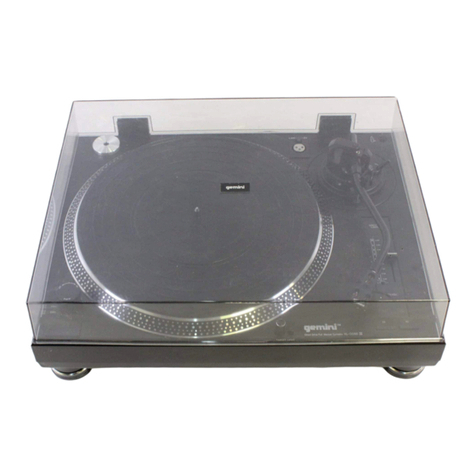
Gemini
Gemini XL-DD50 IV E User manual

Gemini
Gemini TT-02 MKII User manual
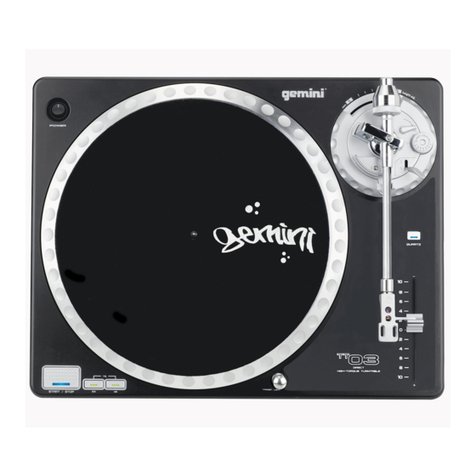
Gemini
Gemini TT-03 User manual
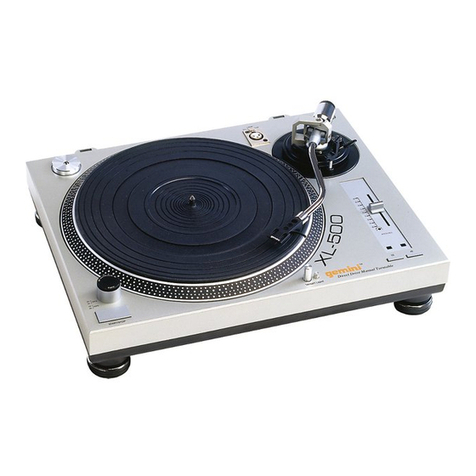
Gemini
Gemini XL-500 User manual
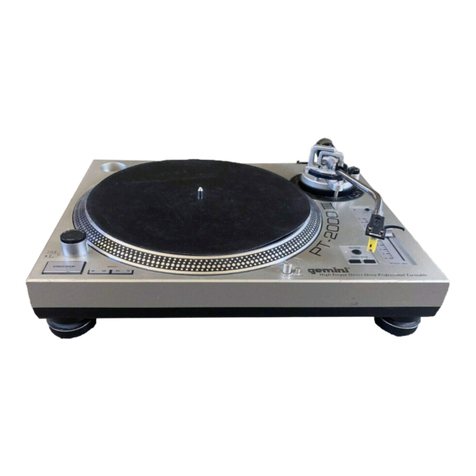
Gemini
Gemini PT-2000 III User manual
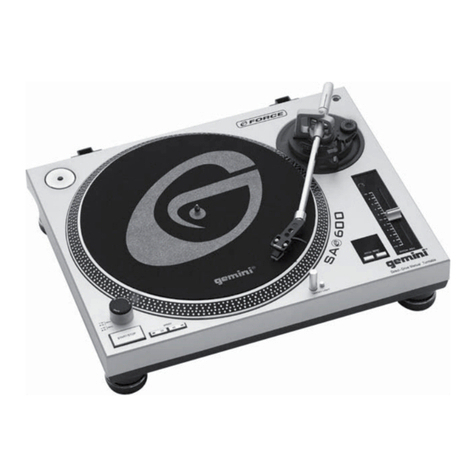
Gemini
Gemini SA-600 User manual

Gemini
Gemini XL-500 ll User manual
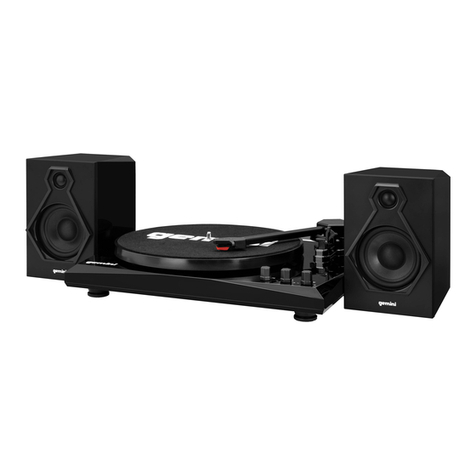
Gemini
Gemini TT-900 User manual
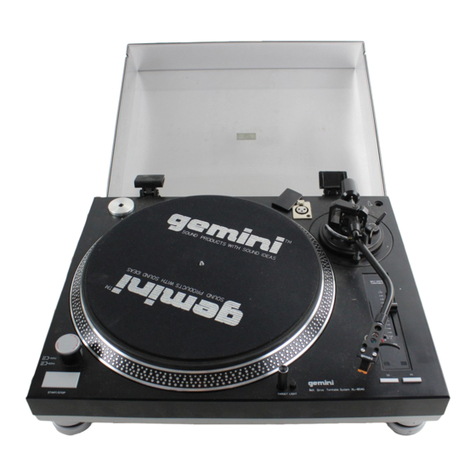
Gemini
Gemini XL-BD40 User manual
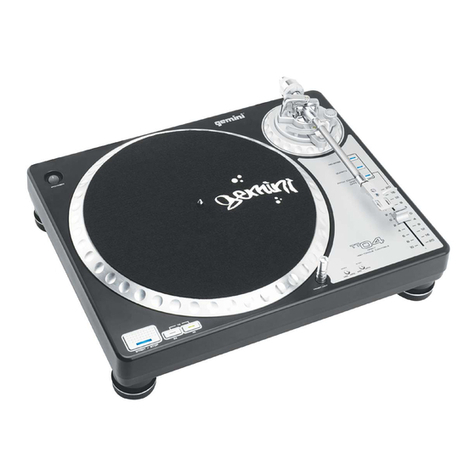
Gemini
Gemini TT-04 User manual
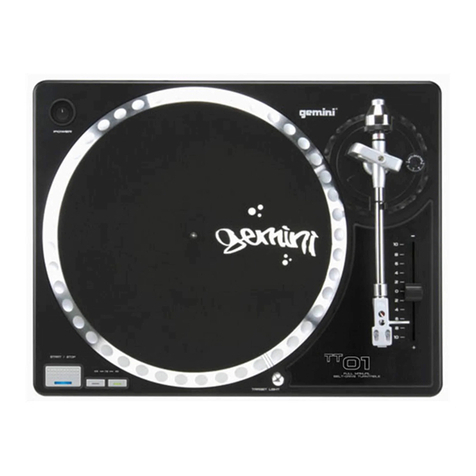
Gemini
Gemini TT-01mkii User manual
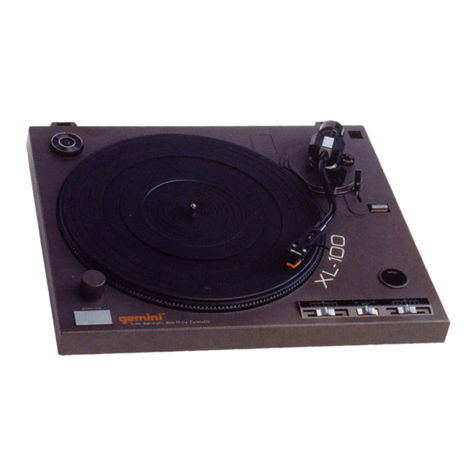
Gemini
Gemini XL-100 User manual

Gemini
Gemini PT-2400 User manual

Gemini
Gemini TT-900 User manual
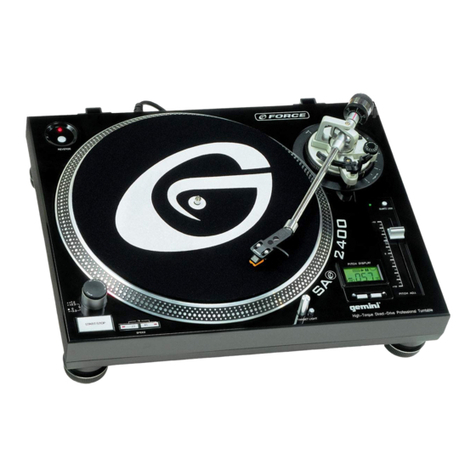
Gemini
Gemini SA-2400 User manual
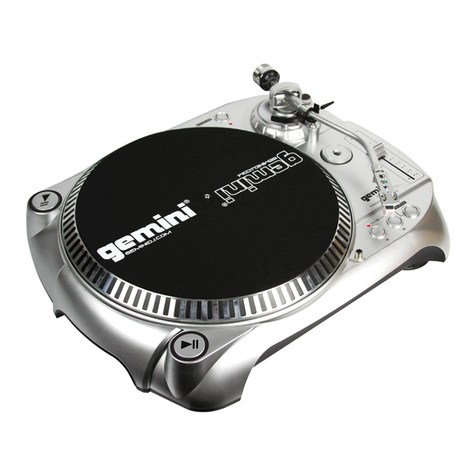
Gemini
Gemini TT-1000 User manual
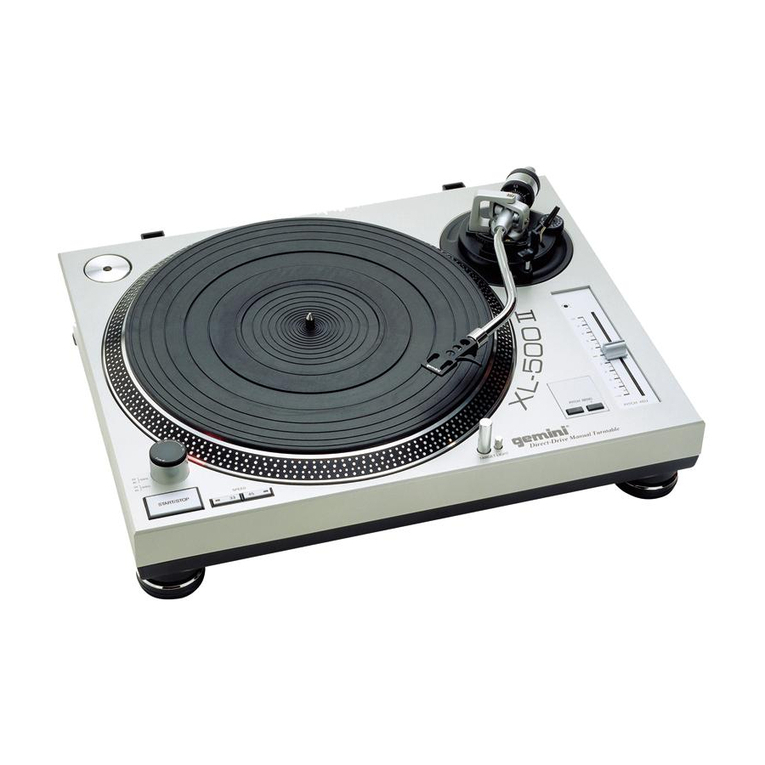
Gemini
Gemini XL 500 II XL-500II XL-500II User manual
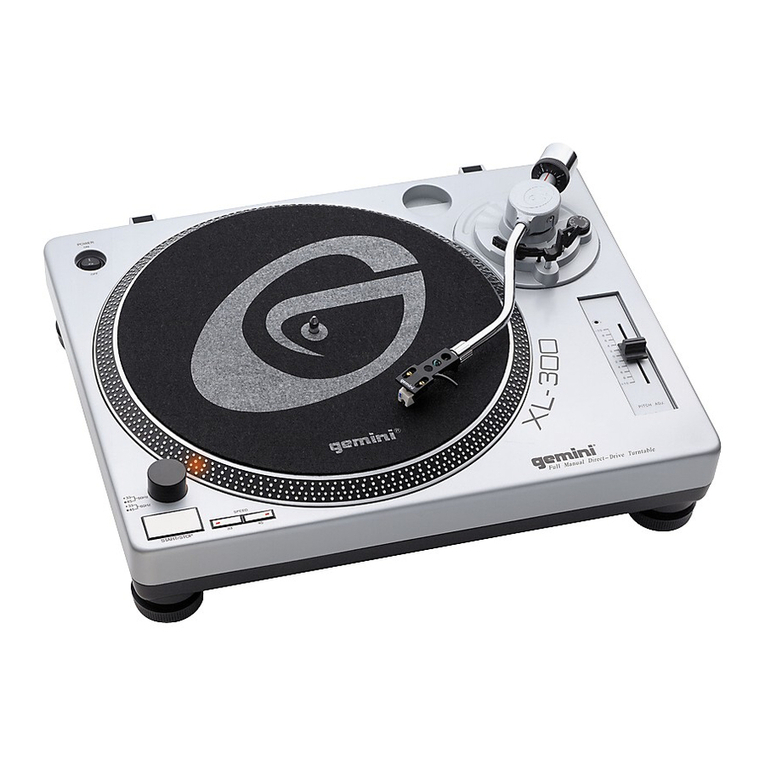
Gemini
Gemini XL-300 User manual
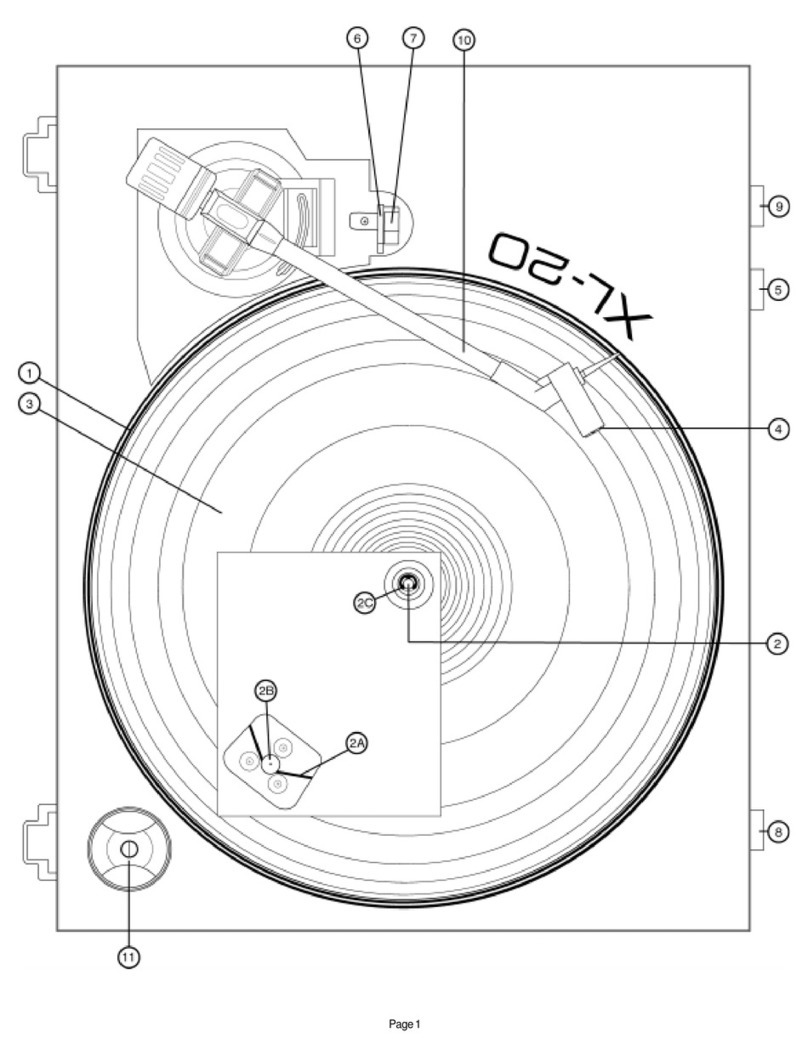
Gemini
Gemini XL-20 User manual
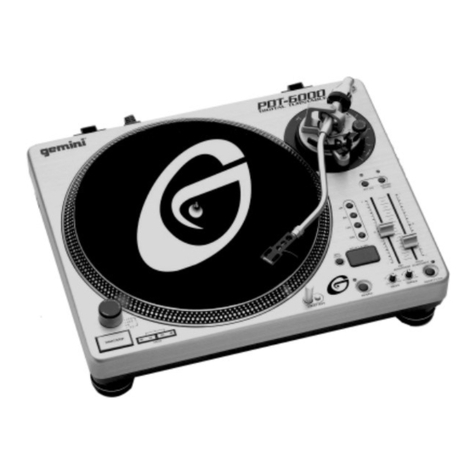
Gemini
Gemini PDT-6000 User manual
